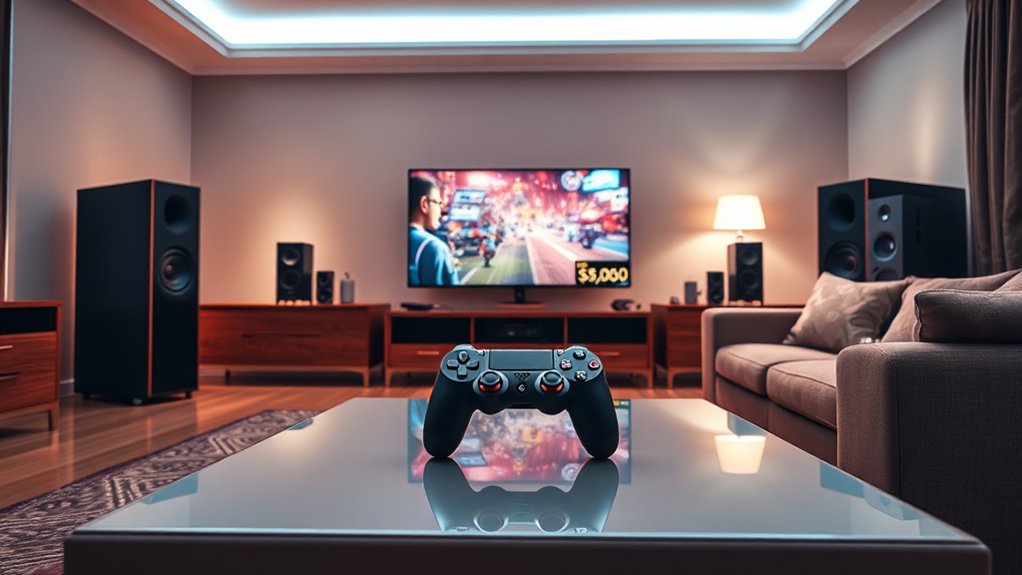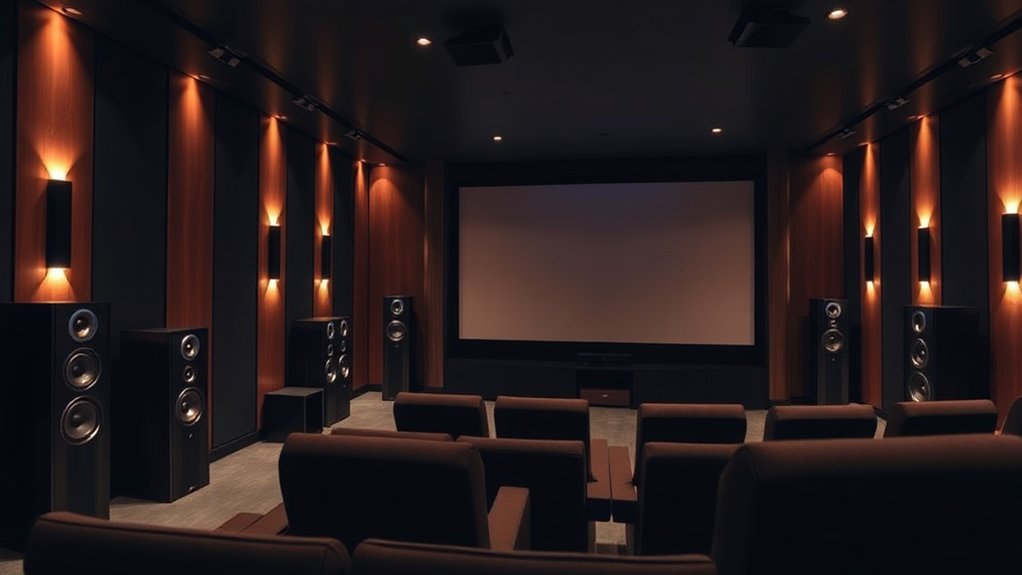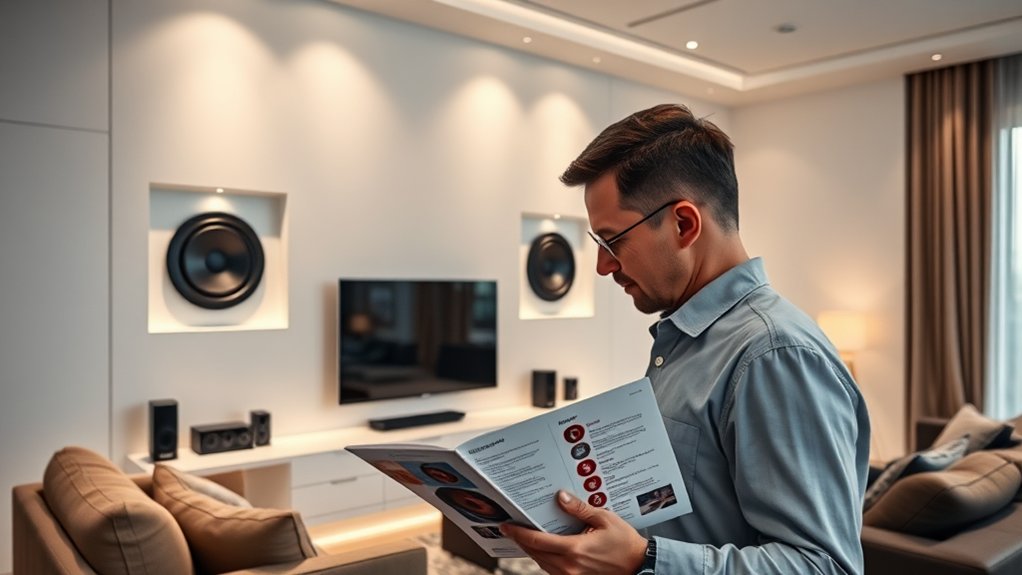Choosing the right home theater speakers for gaming can make all the difference in your play experience. First, think about the type—like 5.1 surround sound for immersion or 2.1 systems for solid bass. Then, consider sound quality, focusing on clarity and bass response. Connectivity matters too, so look for HDMI options. Finally, think about room acoustics: hard surfaces can mess with sound clarity. Curious about advanced features that could enhance your setup? Well, there’s more to investigate!
Key Highlights
- Choose speaker types based on your space and gaming needs, opting for 2.1 or 5.1 systems for enhanced audio immersion.
- Ensure a wide frequency response and good bass performance for clearer sound across all game scenarios.
- Check connectivity options like HDMI ARC and USB for seamless integration with gaming consoles and PCs.
- Look for high-quality materials, like wood cabinets, to improve sound fidelity and durability in speaker design.
- Consider room acoustics and soft furnishings to reduce echoes and enhance overall audio clarity during gameplay.
Understanding Speaker Types for Gaming
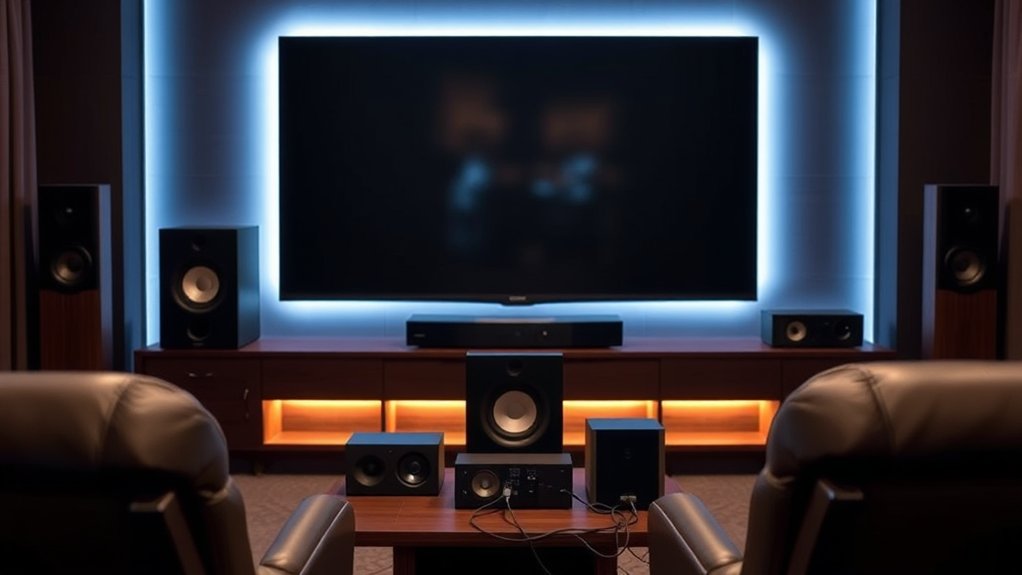
In relation to setting up the ideal gaming experience, understanding the different types of speakers can make a world of difference—not just for auditory feedback but for immersing yourself in your virtual adventures.
You’ve got options like 2.0 stereo speakers, which are great for simplicity in PC gaming—perfect if space is tight. If you want deeper bass, consider a 2.1 system; it adds a subwoofer to improve those explosive moments. For a more immersive experience, a 5.1 surround sound system surrounds you with audio, pivotal in competitive gaming. On the other hand, if you prefer fewer devices, virtual surround sound speakers replicate that experience using clever algorithms. Additionally, investing in high audio quality speakers can significantly enhance immersion during gameplay. Quality speakers can make a notable difference in how you perceive game environments and soundtracks as well. Moreover, options like immersive audio technologies can significantly elevate your audio experience, providing depth and clarity that enhances your gaming sessions. Soundbars are compact, but do they deliver the same thrill? Spoiler alert: probably not!
Key Sound Quality Characteristics to Consider
Choosing the right speakers for gaming isn’t just about picking something that fits; it’s about prioritizing sound quality characteristics that can markedly boost your overall experience.
Start with frequency response—look for a wide range, as deep lows amplify explosions, as clear mids and highs bring dialog and effects like footsteps to life. A sound system with integrated amplifiers can further enhance the sound, eliminating the need for additional equipment. Additionally, consider that floor-standing speakers can provide a taller soundstage, improving immersive gameplay. The ideal system, such as the JBL Bar 1000, delivers an excellent surround sound experience that can heighten your gaming sessions.
Next, soundstage and imaging play crucial roles; a well-designed setup allows you to pinpoint enemy movements in 3D space.
Don’t forget about bass performance—a powerful subwoofer can make those heart-thumping moments feel more real.
Finally, clarity and dynamic range guarantee you hear subtle sounds without distortion, making the difference between victory and defeat in competitive gaming. Who wouldn’t want that edge?
Connectivity and Compatibility for Gaming Systems
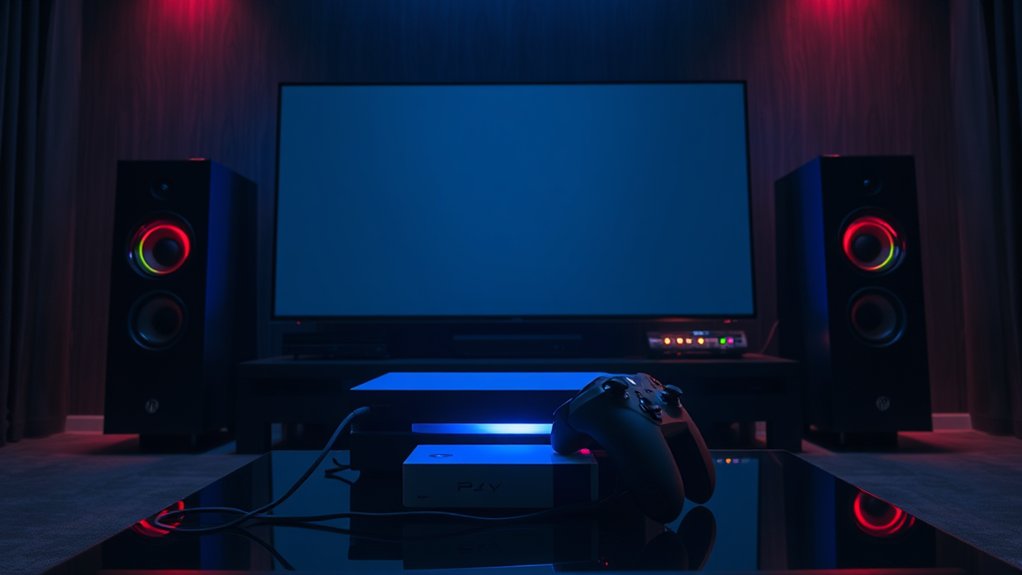
How important is it to match your gaming speakers with your system’s connectivity options? Extremely! Your gaming experience can hinge on this compatibility.
For most modern consoles like the PS5 or Xbox Series X, HDMI ARC or eARC provides a seamless connection, offering high-quality audio and reducing cable clutter. Meanwhile, optical connections excel at delivering surround sound formats, like Dolby Digital, perfect for that immersive gaming feel. The Samsung HW-S800B, for example, supports Dolby Atmos formats to elevate your audio experience further.
If you game on a PC, USB and 3.5mm jacks are your go-tos, but don’t underestimate good old RCA connectors for consistency. Additionally, some sound cards can generate discrete surround sound through their multichannel analog outputs, enhancing your gaming audio quality significantly.
Just remember, more advanced speakers may connect wirelessly via Bluetooth or Wi-Fi; just watch out for that annoying latency. It’s a game-changer, literally!
Power Requirements and Speaker Configuration
When you set up your home theater for gaming, understanding power requirements and speaker configuration isn’t just important—it’s vital for maximizing your experience.
Most home theater speakers perform well at around 100 watts per channel, perfect for standard listening levels. If you’re in a smaller room, you might get by with lower wattage—think 15 to 50 watts.
Home theater speakers thrive at 100 watts per channel for optimal sound, but smaller spaces may only need 15 to 50 watts.
Speaker impedance matters too; match it to your amplifier to avoid performance headaches.
Are you aiming for that immersive surround sound? A 5.1 or 7.1 channel setup can improve gameplay considerably. Additionally, consider budget speakers like the Polk T15, which offer commendable performance at an affordable price point.
Just remember, the more speakers you add, the more power you’ll need. So, make sure you have a sturdy amplifier to handle the demands—your adventures in gaming will definitely thank you!
Material and Build Quality for Durability and Performance
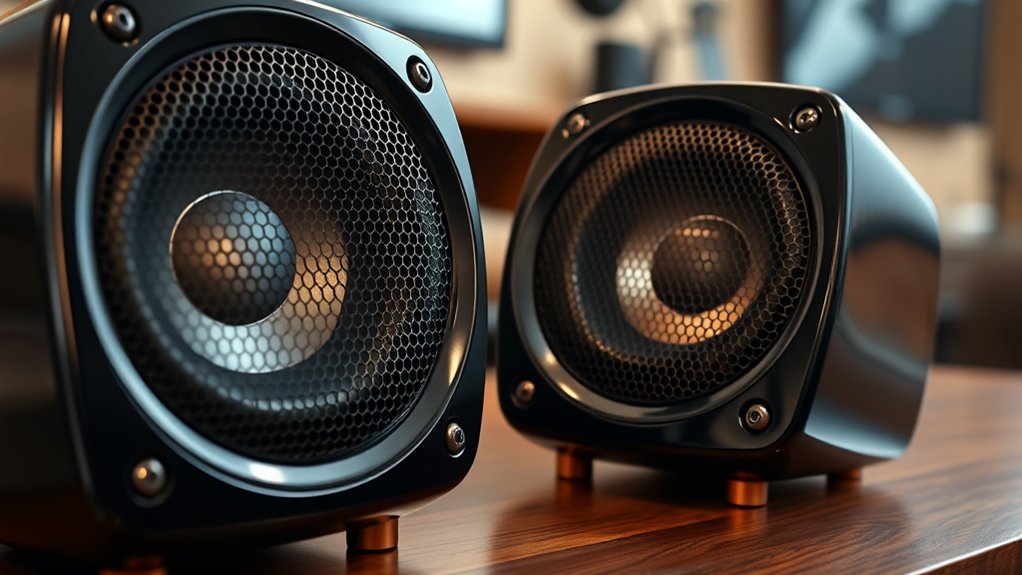
Though you might be tempted to prioritize flashy features when choosing home theater speakers for gaming, the material and build quality play a crucial role in your overall audio experience.
Think about it: wouldn’t you rather have speakers that not only look good but additionally deliver clear, immersive sound?
Wood cabinets, like Baltic Birch plywood, dampen vibrations beautifully, enhancing audio fidelity. Conversely, plastic can distort sound through unwanted resonance, and metal? Well, it might introduce some harsh tones if not carefully managed.
Moreover, don’t overlook cone materials; aramid fiber offers excellent rigidity and dampening.
Budget-Friendly Options vs. Premium Choices
Are you torn between budget-friendly home theater speakers and premium options for your gaming setup?
On one hand, budget systems like the Logitech Z906 offer solid sound with THX certification, wrapping you in immersive audio without breaking the bank. They’re compact and practical, perfect for smaller spaces and everyday use.
Budget systems like the Logitech Z906 deliver immersive audio and practicality, perfect for enhancing your gaming without stretching your wallet.
Yet, if you crave that unparalleled sound experience, premium choices like the Razer Namo Pro deliver outstanding clarity and powerful bass, making every gaming moment truly exhilarating.
Certainly, premium speakers often come with fancy features, but isn’t it satisfying to know you can find a decent budget option that still brings a grin to your face during intense gameplay?
It’s all about finding what fits your style and needs! Moreover, considering options like the R1280DB’s Bluetooth connectivity can enhance your overall audio experience, adding versatility to your setup.
Room Size and Acoustic Considerations
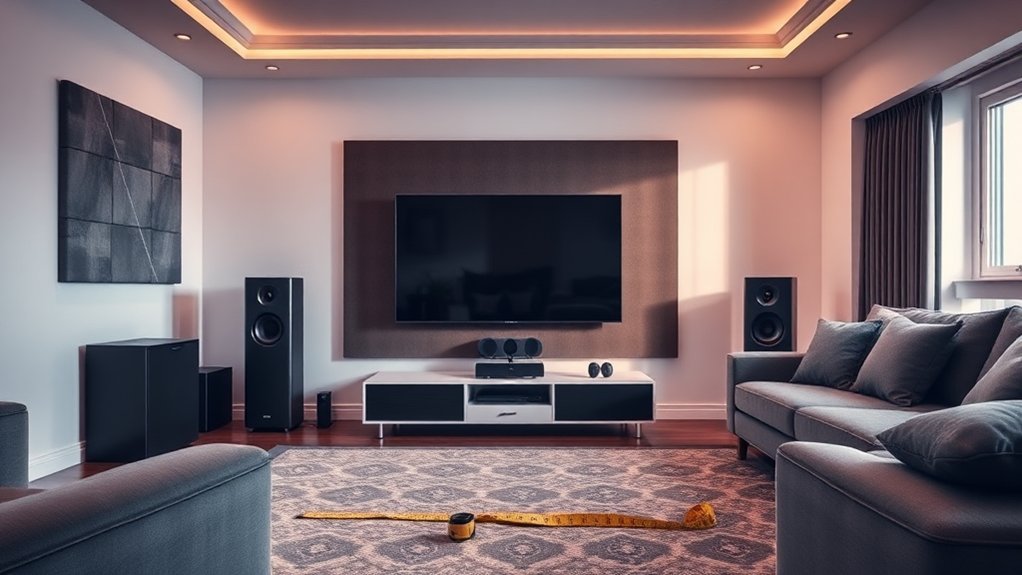
Choosing the right home theater speakers for your gaming setup depends heavily on your room size and its unique acoustic characteristics.
If you’re in a smaller room, compact speakers like bookshelves paired with a suited subwoofer will do the trick, preventing bass from overwhelming the space.
For medium rooms, mid-sized towers can improve audio without distortion, whereas larger areas require powerful towers to distribute sound evenly.
Remember, ceiling height and room shape matter—rectangular layouts are ideal for sound flow, unlike less forgiving square ones.
In addition, hard surfaces can create annoying echoes, so consider soft furnishings or dedicated acoustic panels.
After all, nobody wants gaming audio that sounds like it’s trapped in a tin can, right?
Enhancing Your Gaming Experience With Advanced Features
Wondering how to take your gaming experience to the next level? Advanced features in home theater speakers can create an immersive environment that transports you right into the game.
Think of Dolby Atmos, which adds height channels for 3D audio, or DTS:X, which moves sound around you like an elusive enemy—pretty cool, right?
Dolby Atmos creates 3D audio, while DTS:X surrounds you with sound—immerse yourself in the game like never before!
Plus, with multiple connectivity options, from HDMI to Bluetooth, you can effortlessly connect your gaming systems.
Want to tune sound for a first-person shooter versus a heart-pounding racing game? Customizable EQ presets let you do just that.
And if you prefer voice control with your gaming snacks, some systems even integrate with voice assistants. Additionally, effective noise isolation enhances focus, allowing you to immerse fully in the game.
Now, how’s that for leveling up your experience?
Frequently Asked Questions
Can I Use My Existing Stereo System for Gaming Audio?
Yes, you can use your existing stereo system for gaming audio. Although it provides clear sound, it may lack immersive surround effects. Ensure your setup is compatible with your gaming console or PC for ideal quality.
How Do I Position Speakers for Optimal Soundstage?
To achieve ideal soundstage, position your left and right speakers to form an equilateral triangle with your listening spot. Confirm the center channel aligns with your ear level for clarity, adjusting angles for preferences.
What Audio Formats Improve Gaming Experiences?
To improve your gaming experience, consider using Dolby Atmos for immersive sound, or 5.1 and 7.1 surround formats for realistic audio. Lossless codecs like FLAC elevate sound quality, making gaming more engaging and enjoyable.
Are There Wireless Speaker Systems Specifically for Gaming?
Yes, there are wireless speaker systems particularly designed for gaming. They offer low-latency audio transmission, surround sound capabilities, and adjustable EQ settings to improve your immersive gaming experience without the hassle of tangled cables.
How Often Should I Upgrade My Home Theater Speakers?
You should consider upgrading your home theater speakers every 5 to 7 years, especially if you notice sound quality drops or face compatibility issues with newer components. Regular maintenance can likewise extend their lifespan considerably.

